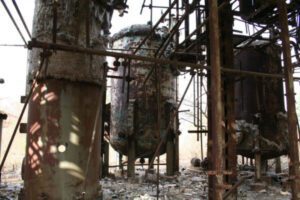EPCRA: Emergency Planning and the Right-to-Know
March 31, 2015
Presage to the Emergency Planning and Community Right-To-Know Act (EPCRA)
Bhopal, India, December 3rd, 1984. An accidental release of 45 tons of methyl isocyanate (MIC), an extremely toxic chemical, at an Indian subsidiary of the American corporation, Union Carbide—a pesticide plant—kills over 2,000 people and injures more than 500,000. By the next morning, it was widely called the worst industrial disaster the world had ever seen.
Institute, W.V., August 11th, 1985. A 3,500 pound toxic chemical leak at the Union Carbide plant sends 135 local residents to nearby hospitals. The company acknowledges that derivatives of methyl isocyanate (MIC) made up a portion of the leak. The Environmental Protection Agency (EPA) tests for MIC in the storage tanks in which the release occurred.
This is how headlines of the day read. Soon after these two very similar leaks, the need for an increased preparedness for emergency response and also a community “right-to-know” about dangerous chemicals was realized.
Congress passed the Emergency Planning and Community Right-to-Know Act (EPCRA) in 1986. The act promulgates a required level emergency preparedness of federal, state, local governments, tribal nations, and applicable industries. It also provides for public access to information on dangerous chemicals used in specific facilities across the nation.
By becoming more well informed of these toxic chemicals, of their uses, misuses, and potential harm, it was hoped, the safer our communities and the environment would be.
Directly following the EPA’s guidelines, EPCRA covers four main areas, including:
- Emergency planning (sections 301-303),
- Emergency release notification (section 304),
- Hazardous chemical storage reporting requirements (sections 311-312), and
- Toxic chemical release inventory (section 313).
Emergency Plans
Emergency plans are broken down into several requirements, and must be updated annually. These requirements are set by the EPA, and include:
- Identify facilities and transportation routes of extremely hazardous substances
- Describe emergency response procedures, on and off site
- Designate a community coordinator and facility coordinator to implement the plan
- Outline emergency notification procedures
- Describe how to determine the probable affected area and population by releases
- Describe local emergency equipment and facilities and the persons responsible for them
- Outline evacuation plans
- Provide a training program for emergency responders (including schedules)
- Provide methods and schedules for exercising emergency response plans
Emergency Release Notification
Release notification must be supplied to local authorities, including the fire department. The necessary information in the case of a release may include:
- The chemical name;
- An indication of whether it is an extremely hazardous substance;
- An estimate of the quantity released into the environment;
- The time and duration of the release;
- Whether the release occurred into air, water, and/or land;
- Any known or anticipated acute or chronic health risks associated with the emergency, and where necessary, advice regarding medical attention for exposed individuals;
- Proper precautions, such as evacuation or sheltering in place; and,
- Name and telephone number of contact person.
Toxic Release Inventory
On July 1st of each year, hazardous waste facilities must submit a Toxic Release Inventory (TRI) report to the EPA. This inventory tracks what chemicals were used or handled that year, and how they were managed.
More information on the TRI and annual EPA reporting can be found at epa.gov/tri.
Right-to-Know
The right-to-know provisions include the maintaining of Material Safety Data Sheets (MSDS) for each hazardous chemical used in a facility. Over 500,000 chemicals must have a MSDS. Facilities must also submit MSDSs or a list of used chemicals to local authorities in case of an accident or spill.


